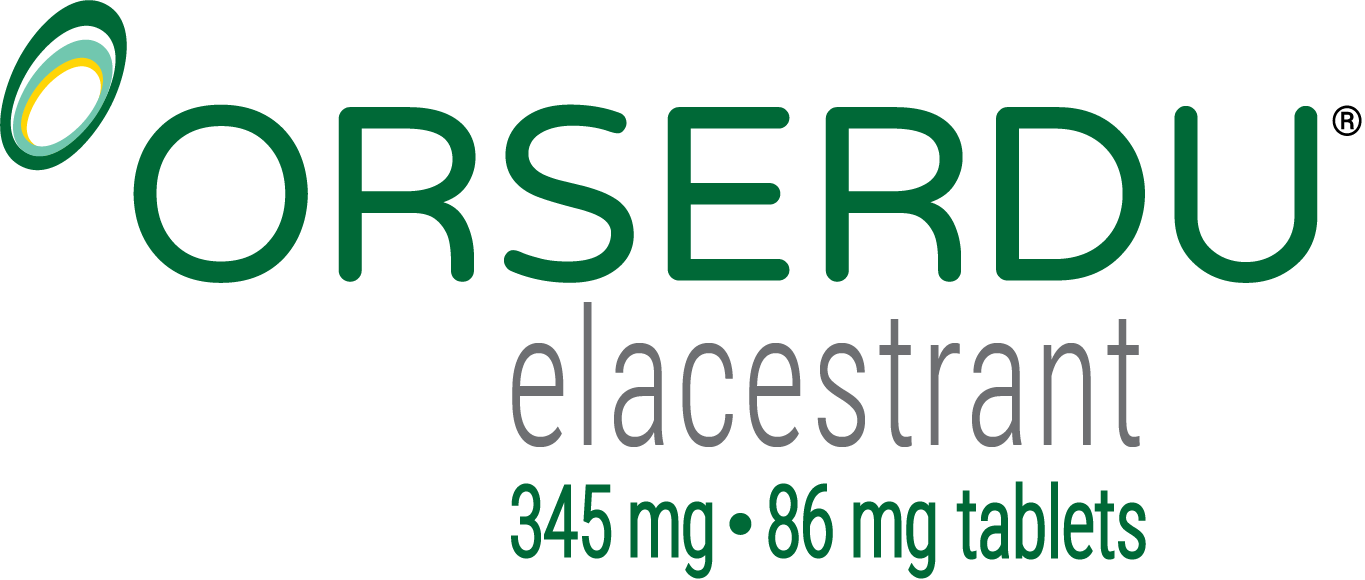
For US Healthcare Professionals
In ESR1-mutated, ER+/HER2- mBC following progression on ET
ORSERDU: 2x mPFS vs fulvestrant or AI1*
ORSERDU demonstrated 45% risk reduction1
HR=0.55 (95% CI: 0.39-0.77); P=0.0005
*AI therapy included anastrozole, letrozole, or exemestane.1
†Results of exploratory post hoc analyses are descriptive but not conclusive of efficacy, are not controlled for type 1 error, and require cautious interpretation. Small patient numbers can be a limitation of subgroup analyses and could represent chance findings.
Primary
endpoint in EMERALD
3.8 months
mPFS
(95% CI: 2.2-7.3) vs 1.9 months
(95% CI: 1.9-2.1) for fulvestrant or AI1*
Exploratory
post hoc analysis†
Patients with prior
ET + CDK4/6i for ≥12 months
8.6 months
mPFS
(95% CI: 4.1-10.8)
vs 1.9 months
(95% CI: 1.9-3.7) for fulvestrant or AI*
HR=0.41 (95% CI: 0.26-0.63)2
Real-world evidence in >1,000 patients from 2 published analyses3,4
Limitations of real-world evidence: Real-world, observational, retrospective analyses are designed to evaluate associations among variables and cannot establish causality between treatments and outcomes. Analyses can be associated with methodological challenges, and a high frequency of censoring has the potential to limit the validity of results. There is potential for missing, inaccurate, or incomplete data. Bias related to treatment selection and unobserved variables may not be fully addressed. Results are not intended to be compared with clinical trials and should be interpreted with caution.
TRIAL DESIGN: EMERALD was an open-label, global, phase 3 trial of postmenopausal women or men with confirmed ER+/HER2- metastatic breast cancer (N=478) who had progressed after 1-2 lines of ET, at least one in combination with a CDK4/6i, randomized (1:1) to receive ORSERDU or endocrine therapy (fulvestrant) or an aromatase inhibitor (anastrozole, letrozole, or exemestane). A major efficacy endpoint was PFS by BIRC in patients with ESR1m (n=228). An exploratory post hoc analysis evaluated efficacy and safety in patients with ESR1m treated with prior ET + CDK4/6i for ≥12 months (n=159).1,2
AI, aromatase inhibitor; BIRC, blinded imaging review committee; CDK4/6i, cyclin-dependent kinase 4/6 inhibitor; CI, confidence interval; ER+, estrogen receptor-positive; ESR1, estrogen receptor 1; ESR1m, estrogen receptor 1 mutation; ET, endocrine therapy; HER2-, human epidermal growth factor receptor 2-negative; HR, hazard ratio; mBC, metastatic breast cancer; mPFS, median progression-free survival; PFS, progression-free survival.
INDICATION
ORSERDU (elacestrant) is indicated for the treatment of postmenopausal women or adult men with estrogen receptor (ER)-positive, human epidermal growth factor receptor 2 (HER2)-negative, ESR1-mutated advanced or metastatic breast cancer with disease progression following at least one line of endocrine therapy.
IMPORTANT SAFETY INFORMATION
Warnings and Precautions
-
Dyslipidemia: Hypercholesterolemia and hypertriglyceridemia occurred in patients taking ORSERDU at an incidence of 30% and 27%, respectively. The incidence of Grade 3 and 4 hypercholesterolemia and hypertriglyceridemia were 0.9% and 2.2%, respectively. Monitor lipid profile prior to starting and periodically while taking ORSERDU.
-
Embryo-Fetal Toxicity: Based on findings in animals and its mechanism of action, ORSERDU can cause fetal harm when administered to a pregnant woman. Advise pregnant women and females of reproductive potential of the potential risk to a fetus. Advise females of reproductive potential to use effective contraception during treatment with ORSERDU and for 1 week after the last dose. Advise male patients with female partners of reproductive potential to use effective contraception during treatment with ORSERDU and for 1 week after the last dose.
Adverse Reactions
-
Serious adverse reactions occurred in 12% of patients who received ORSERDU. Serious adverse reactions in >1% of patients who received ORSERDU were musculoskeletal pain (1.7%) and nausea (1.3%). Fatal adverse reactions occurred in 1.7% of patients who received ORSERDU, including cardiac arrest, septic shock, diverticulitis, and unknown cause (one patient each).
-
The most common adverse reactions (≥10%), including laboratory abnormalities, of ORSERDU were musculoskeletal pain (41%), nausea (35%), increased cholesterol (30%), increased AST (29%), increased triglycerides (27%), fatigue (26%), decreased hemoglobin (26%), vomiting (19%), increased ALT (17%), decreased sodium (16%), increased creatinine (16%), decreased appetite (15%), diarrhea (13%), headache (12%), constipation (12%), abdominal pain (11%), hot flush (11%), and dyspepsia (10%).
Drug Interactions
-
Concomitant use with CYP3A4 inducers and/or inhibitors: Avoid concomitant use of strong or moderate CYP3A4 inhibitors with ORSERDU. Avoid concomitant use of strong or moderate CYP3A4 inducers with ORSERDU.
Use in Specific Populations
-
Lactation: Advise lactating women to not breastfeed during treatment with ORSERDU and for 1 week after the last dose.
-
Hepatic Impairment: Avoid use of ORSERDU in patients with severe hepatic impairment (Child-Pugh C). Reduce the dose of ORSERDU in patients with moderate hepatic impairment (Child-Pugh B).
The safety and effectiveness of ORSERDU in pediatric patients have not been established.
ORSERDU is available as 345 mg tablets and 86 mg tablets.
To report SUSPECTED ADVERSE REACTIONS, contact Stemline Therapeutics, Inc. at 1-877-332-7961 or FDA at 1-800-FDA-1088 or www.fda.gov/medwatch.
Please see full Prescribing Information.
References: 1. ORSERDU [prescribing information]. New York, NY: Stemline Therapeutics, Inc., a Menarini Group Company, 2023. 2. Bardia A, Cortés J, Bidard FC, et al. Elacestrant in ER+, HER2- metastatic breast cancer with ESR1-mutated tumors: subgroup analyses from the phase III EMERALD trial by prior duration of endocrine therapy plus CDK4/6 inhibitor and in clinical subgroups. Clin Cancer Res. 2024;30(19):4299-4309. 3. Lloyd MR, Weipert CM, Ali A, et al. Clinical and genomic factors associated with elacestrant outcomes in ESR1-mutant metastatic breast cancer. Clin Cancer Res. Published online November 7, 2025. doi:10.1158/1078-0432.CCR-25-3033 4. Rugo HS, Kaklamani V, McArthur H, et al. Real-world outcomes of elacestrant in ER+, HER2-, ESR1-mutant metastatic breast cancer. Clin Cancer Res. Published online November 14, 2025. doi:10.1158/1078-0432.CCR-25-3040
This site is intended only for US healthcare professionals. The products discussed in this site may have different product labeling in different countries. The information provided is for educational purposes only.
ORSERDU is a registered trademark of the Menarini Group.
© 2025 Stemline Therapeutics, Inc., a Menarini Group Company. All rights reserved. 12/25 MAT-US-ELA-00969-v3
|
IMPORTANT SAFETY INFORMATION
+
Warnings and Precautions
-
Dyslipidemia: Hypercholesterolemia and hypertriglyceridemia occurred in patients taking ORSERDU at an incidence of 30% and 27%, respectively. The incidence of Grade 3 and 4 hypercholesterolemia and hypertriglyceridemia were 0.9% and 2.2%, respectively. Monitor lipid profile prior to starting and periodically while taking ORSERDU.
-
Embryo-Fetal Toxicity: Based on findings in animals and its mechanism of action, ORSERDU can cause fetal harm when administered to a pregnant woman. Advise pregnant women and females of reproductive potential of the potential risk to a fetus. Advise females of reproductive potential to use effective contraception during treatment with ORSERDU and for 1 week after the last dose. Advise male patients with female partners of reproductive potential to use effective contraception during treatment with ORSERDU and for 1 week after the last dose.
Adverse Reactions
-
Serious adverse reactions occurred in 12% of patients who received ORSERDU. Serious adverse reactions in >1% of patients who received ORSERDU were musculoskeletal pain (1.7%) and nausea (1.3%). Fatal adverse reactions occurred in 1.7% of patients who received ORSERDU, including cardiac arrest, septic shock, diverticulitis, and unknown cause (one patient each).
-
The most common adverse reactions (≥10%), including laboratory abnormalities, of ORSERDU were musculoskeletal pain (41%), nausea (35%), increased cholesterol (30%), increased AST (29%), increased triglycerides (27%), fatigue (26%), decreased hemoglobin (26%), vomiting (19%), increased ALT (17%), decreased sodium (16%), increased creatinine (16%), decreased appetite (15%), diarrhea (13%), headache (12%), constipation (12%), abdominal pain (11%), hot flush (11%), and dyspepsia (10%).
Drug Interactions
-
Concomitant use with CYP3A4 inducers and/or inhibitors: Avoid concomitant use of strong or moderate CYP3A4 inhibitors with ORSERDU. Avoid concomitant use of strong or moderate CYP3A4 inducers with ORSERDU.
Use in Specific Populations
-
Lactation: Advise lactating women to not breastfeed during treatment with ORSERDU and for 1 week after the last dose.
-
Hepatic Impairment: Avoid use of ORSERDU in patients with severe hepatic impairment (Child-Pugh C). Reduce the dose of ORSERDU in patients with moderate hepatic impairment (Child-Pugh B).
The safety and effectiveness of ORSERDU in pediatric patients have not been established.
ORSERDU is available as 345 mg tablets and 86 mg tablets.
INDICATION
ORSERDU (elacestrant) is indicated for the treatment of postmenopausal women or adult men with estrogen receptor (ER)-positive, human epidermal growth factor receptor 2 (HER2)-negative, ESR1-mutated advanced or metastatic breast cancer with disease progression following at least one line of endocrine therapy.
To report SUSPECTED ADVERSE REACTIONS, contact Stemline Therapeutics, Inc. at 1-877-332-7961 or FDA at 1-800-FDA-1088 or www.fda.gov/medwatch.
Please see full Prescribing Information.
References: 1. ORSERDU [prescribing information]. New York, NY: Stemline Therapeutics, Inc., a Menarini Group Company, 2023. 2. Bardia A, Cortés J, Bidard FC, et al. Elacestrant in ER+, HER2- metastatic breast cancer with ESR1-mutated tumors: subgroup analyses from the phase III EMERALD trial by prior duration of endocrine therapy plus CDK4/6 inhibitor and in clinical subgroups. Clin Cancer Res. 2024;30(19):4299-4309. 3. Lloyd MR, Weipert CM, Ali A, et al. Clinical and genomic factors associated with elacestrant outcomes in ESR1-mutant metastatic breast cancer. Clin Cancer Res. Published online November 7, 2025. doi:10.1158/1078-0432.CCR-25-3033 4. Rugo HS, Kaklamani V, McArthur H, et al. Real-world outcomes of elacestrant in ER+, HER2-, ESR1-mutant metastatic breast cancer. Clin Cancer Res. Published online November 14, 2025. doi:10.1158/1078-0432.CCR-25-3040

